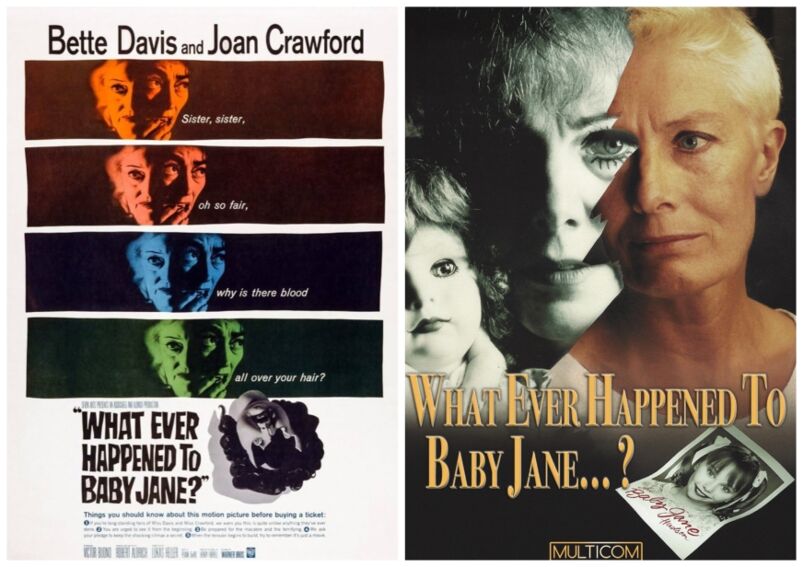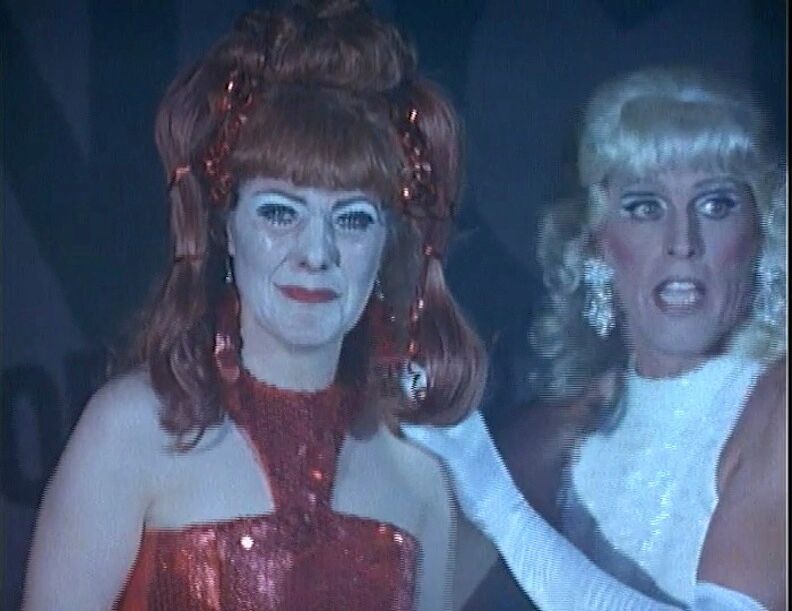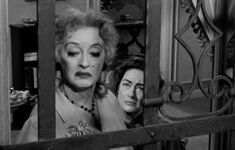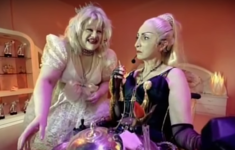
Welcome back to our queer film retrospective, “A Gay Old Time.” In the spirit of Thanksgiving, this week’s column revisits a real family affair: The 1991 made-for-TV remake of What Ever Happened To Baby Jane?
There are many reasons why a film becomes a queer classic—the kind our community will quote, reference and pull from on a regular basis, appealing to our very particular sensibilities: Performances that are as large as they are intimate and raw. Biting, razor-sharp lines of dialogue. Themes that speak to the socially outcast, or those longing for something more. We’ve covered many of these classics in this column before.
Which is why it’s so tricky and risky (some would say impossible) to remake a classic.
So many of these elements are so difficult to capture on their own—let alone all in a single movie—that even an attempt feels ill-fated at best, and completely doomed at worst. In the case of one of the most beloved, controversial, quotable, and historically rich queer classics, how does the idea of a remake even stand a chance?
Well, as it turns out, the 1991 version of What Ever Happened To Baby Jane? (all all-timer in the queer film pantheon) not only manages to go head-to-head with some of the elements that made the original a camp classic, but it also redefines itself to be something completely different. In many ways, the update even manages to appeal more directly to what has made it an everlasting presence in our culture.
The Set-Up
For the uninitiated, What Ever Happened to Baby Jane? follows two sisters: former child star Baby Jane, and her sister Blanche, who surpassed Jane in fame as they grew older, until an accident left her paralyzed. The two of them now live in a secluded mansion, Blanche being totally dependent on her sister, who mistreats and resents her for the love that she feels was stolen from her.
Based on a novel by Henry Farrell, the ’62 version became (in)famous for uniting Joan Crawford and Bette Davis—two screen legends of the Golden Age of Hollywood—at a time in their careers when not many roles were coming their way. Their on-set rivalry became Hollywood lore, and the film kickstarted (and in many ways is the pinnacle) of the “hagsploitation” genre, where former acclaimed actresses play women descending into madness as they pine for their fading glory, youth, and beauty.
Related:
It’s Oscar season. Time to descend into madness
Don’t call it camp.
The combination of Joan and Bette’s performances and personas that they brought to the movie, the nostalgia and satire of old Hollywood, and the earnestness of the melodrama combined with the B-level production value is a thing of beauty. It was also a total product of its time—so much so that a made-for-TV remake (one set in the 1990s) understandably raises some eyebrows.
Sister, Sister

But this version doesn’t seem to want to replicate or imitate the original. It follows the basic premise of the novel, but apart from some nudges and allusions to the 60s film, it tries to be its own thing, with its own interpretation of the story, setting, and tone. By stepping away from the gigantic shadow of the original, it lets its wildest elements shine more.
Here, child star Baby Jane is once again surpassed in fame by Blanche, only for an accident to leave her paralyzed. The two of them are still recluses that feed on nostalgia and resentment for each other. But in what is the most striking narrative difference, this version focuses more on the descent of Jane into madness and a failed attempt at a comeback, rather than a deep examination of the sisterly rivalry and codependence.
They’re played by real-life sisters Vanessa and Lynn Redgrave, both highly acclaimed by this point in their careers. While their performances pale in comparison to the original (It is Joan Crawford and Bette Davis, after all), they’re clearly having a blast. The sense of ease and fun they display while chewing the scenery make it an enjoyable watch—particularly Lynn with her layers of caked makeup and bright red pigtails.
Totally ’90s
This time, it’s not the 1960s looking back at the vaudeville years. It’s the 1990s looking back at Classic Hollywood of the ’50s and ’60s. The film does a great job at portraying how these characters would behave in the changed industry: Blanche looks at her old films on VHS tapes. Jane goes to video stores trying and failing to find her movies. Blanche rides around in an electric scooter.
The way it updates the story and setting is simultaneously ridiculous and fitting. This movie was made for TV, and it looks like such, but the plot is adjusted so that the sleazy, dirty, low-grade feel inherent to the format at the time actually enhances the themes of the story.
Dragging Up The Classics

However, what feels most refreshing and original about this version is how it takes the original’s queer appeal and embeds it directly into the narrative. The character of Edwin (played by Victor Buono in the original) is split into two men here: Dominick (Bruce A. Young), an aide that comes from time to time to help Blanche, and Billy Korn (John Glover) a sleazy gay aspiring artist that partners with Jane, promising her a comeback.
Billy embodies the archetype of a gay fanboy, fawning over an obscure actress’s career, aiming to bring her back into the spotlight, while still holding darker intentions of his own. It seems to be a direct portrayal of the kind of fandom that the original Baby Jane created, weaponizing it and making that character complicit in the mental spiral of the protagonist.
The Ultimate Mother Sister Off
In many ways, remaking a movie seems to be asking for unnecessary criticism and comparison, especially when the original holds an undeniable place in culture. But this take on What Ever Happened To Baby Jane? is able to skirt most of these issues by creating a new world, style, and themes that both embody what the original was about, but also expand and subvert it.
It’s a parody and a remake and an homage, but also its own thing. And the two can coexist. After all this time, the two can still be friends.
David Greene’s What Ever Happened To Baby Jane? is now streaming on Freevee, Hoopla, Pluto TV, The Roku Channel, and Tubi.
Related:
‘Baby Jane’ parody with Courtney Love, Madonna impersonators is uncanny and amazing
The short film by David LaChapelle is shockingly relevant to today.






















dbmcvey
I did see this when it first aired but I have no memories of it. Maybe it’s time for another viewing.
mildredspierce
It was obviously implied that Billy Corn was an evil gay pedophile/drag queen stereotype. Anything “gay” in this made for tv turkey was from an entirely homophobic point of view.
Doug
I agree this is a turkey. I remember watching it when it first aired on tv and it was an embarrassingly bad remake. It disappeared into oblivion after that, where it belongs.
Mr.Gavin Elster
File that 1991 WHTBJ? version under “rip-off,” not remake. A tacky exploitation flick that exploits and wastes the audience’s time, patience and dignity. A waste of rare Redgrave talent. If it had been made earlier they could have dragged-in their gay dad, Michael, and trashed him? Makes the original ’62 Farrell/Aldrich version look like the best of Shakespeare, O’Neil and T. Williams. Another candidate for my anti-preservation film initiative: transfer this to highly flammable, unstable nitrate stock, NOW and make it LOST!
Kangol2
This was a dreadful remake. NO remake of Whatever Happened to Baby Jane? will ever come close to the iconic performances of Bette Davis (who should have received an Academy Award for her turn as Baby Jane Hudson) and Joan Crawford, but also to the tightness of that script and direction. That said, I do love Vanessa Redgrave and Lynn Redgrave as actors; both gave exceptional performances in a number of films, with Vanessa’s best probably in The Bostonians (where she plays a lesbian character), Julia, Morgan!, Isadora, If These Walls Could Talk, and Mary. Queen of Scots and Lynn’s in Georgy Girl and Gods and Monsters.